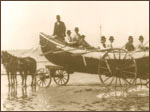| calendar | membership | store | search |

|
| Information | Exhibits | Programs | Races | Events | Get Involved | Home |
| Collections | History | For Researchers |
|
Nantasket Nantasket's performance in the Great Storm of 1888 soon quieted the experts’ doubts. On November 26, 1888, five men clung to the icy rigging of the schooner H.C. Higginson, which lay with decks under water 150 yards off Nantasket Beach. While several unsuccessful attempts were made to affect a breeches buoy rescue, the new Nantasket was towed up the Weir River and hauled over the barrier beach at Black Rock to the ocean. Joshua James and his volunteer crew already were tired from three difficult rescues during the previous day, including the use of Nantasket to save seven seamen from the Bertha F. Walker. Nantasket was launched, but forced back to shore 45 minutes later with two holes driven in her sides. After applying temporary lead patches to the surfboat, the Hull volunteers successfully reached the schooner through tremendous seas. Joshua Jam es modestly described the rescue, saying, “The principle danger in effecting this rescue was from the heavy sea running... It is my opinion that no other boat, except the one we had, could have gotten up alongside of the vessel as far as the main rigging where the men were.” The rescue of the Higginson earned the lifesavers Congressional Silver Life Saving Medals. Later that same day, the crew in Nantasket rescued a single person stranded in the brig Alice. In 1909, a Massachusetts Humane Society document listed Nantasket as the “largest and finest in the Society’s fleet.” She remained in service until 1935, making her way, courtesy of officials in the U.S. Coast Guard, to the Mariners Museum in Newport News, Virginia, in 1939. On the 18th of May, 1985 Nantasket was joyfully drawn through the streets of Hull and returned to a permanent home at the Hull Lifesaving Museum. Nantasket’s record also includes:
|
||||||||||
| contact us | © 2004 Hull Lifesaving Museum | ||||||||||



